UNIT 8 RESEARCH
Hart Club
Hart club is a charity led organisation encouraging neurodiversity in the arts, exhibiting work with the aims to build confidence, community and well-being. They work closely with different organisations who run art clubs for neurodiverse artists, providing a space for them to exhibit the works created during these workshops.
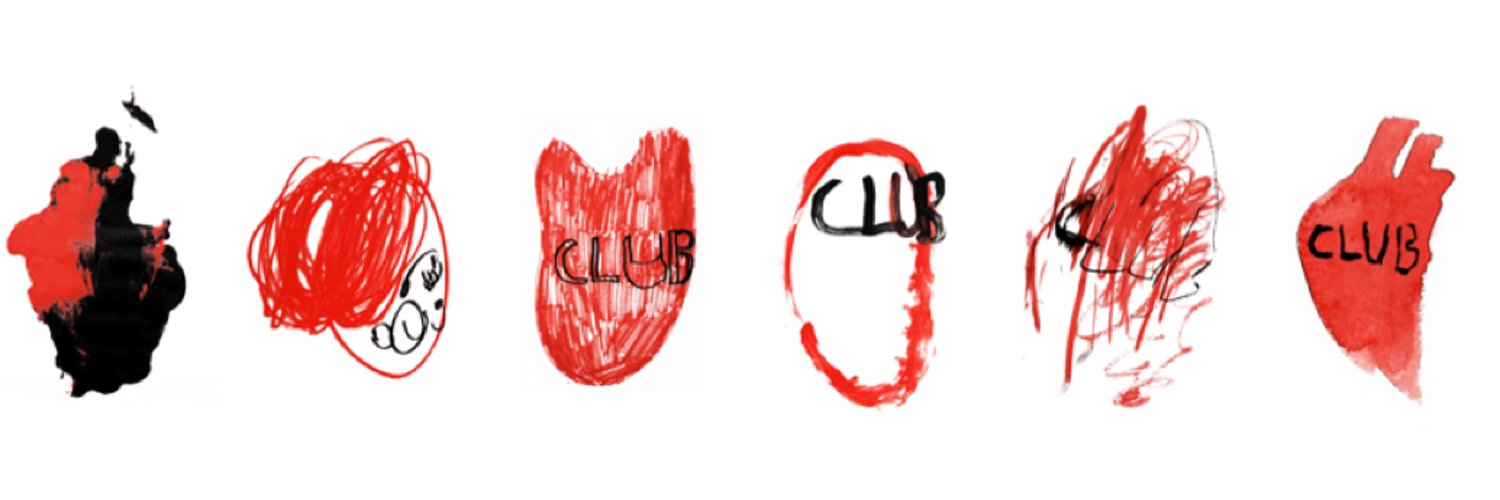
The Great Grey, is a workshop which works with people suffering from dementia, Hart Club provides a space for these workshops to take place, and also an opportunity for the group to display their creations in their gallery space.
Hart club is a very unique place, a small studio in South East London with a printing room and ceramics studio, their walls are decorated with clients art.


The group seemed very relaxed, playing music in the background as the clients painted and had tea, cake and small talk. The leader of the group, an art-psychotherapist, was very relaxed with a friendly relationship with the artists, encouraging them gently to keep creating even when they felt like giving up. After speaking with the group leader, and the lady who runs Hart club, we discussed how it was important to be very sensitive with the group, safe-guarding is a major issue while attending the groups, and although it would be a nice idea to show their work, it would also be exposing their identity, and putting pressure and stress on them they may not want. Therefore I thought we could take a different approach to the project, maybe working with the psychotherapist herself to gain a stronger understanding of the importance of art therapy, how it works and how it benefits the clients. We would like to keep working with the group, but not to learn their stories - which may be difficult and distressing to communicate - but instead to think about the generalised story of art-therapy and how we can apply this to our own workshop.
One of the activities we did was a 'brain-gym', where the leader of the group encouraged us to work in pairs to create a piece in turns, in order to encourage a visual conversation. We first looked at a range of artists, discussed the mood we felt looking at these artists, and cried to create our own piece by applying a similar mood.
Without the clients permission I cannot show their work but in pairs we also created individual pieces, this was mine:

It was nice to see how we were able to inspire each other to create, and how the person I worked with became more animated and more confident as the session progressed.
What is dementia?
Dementia is a syndrome which affects brain functionality, causing problems with:
What is art therapy?
Art therapy is a form of psychotherapy which uses art media as a primary source of expression and communication. Within this context art is used not as a diagnostic tool, but as a medium to express emotional issues which may be confusing or distressing
- BAAT (British Association of Art Therapists)
In this video the client discusses how art-therapy allowed her to visually communicate the difficult body-image issues she was struggling with. The sessions allowed her to channel different difficult emotions such as anger through her art. Finally she felt that the art she was creating provided a distraction from her mental illness, it helped build her confidence and helped her discover a new passion.
In this video the client explains how art therapy allowed her to discuss the elements of her eating disorder which are often difficult to explain such as her relationships to food and meal-times. She discusses how art-therapy allowed her to look back onto her past emotions, which allowed her to recognise her own recovery.
Interactive exhibitions
Interactive exhibitions combine different mediums and technology in the aim to give the audience the role of the exhibition-maker
Welcome to Hard Times was an interactive exhibition in Prague which forced its audience to consider their own involvement in the world today and the political climate, encouraging them to fight back, with things such as political leaders faces on punching bags.
What Made Me was an interactive exhibition designed by Dorota Grabkowska (June 2012). The idea of the project was to map what shaped the city of Birmingham by asking them five questions: What made you think? What made you create? What made you happy? What made you angry? What made you change? Each question assigned a different coloured thread and audience members were encourage to use the thread to connect words in a grid to share thoughts.
https://www.behance.net/gallery/4419469/WHAT-MADE-ME-Interactive-Public-Installation
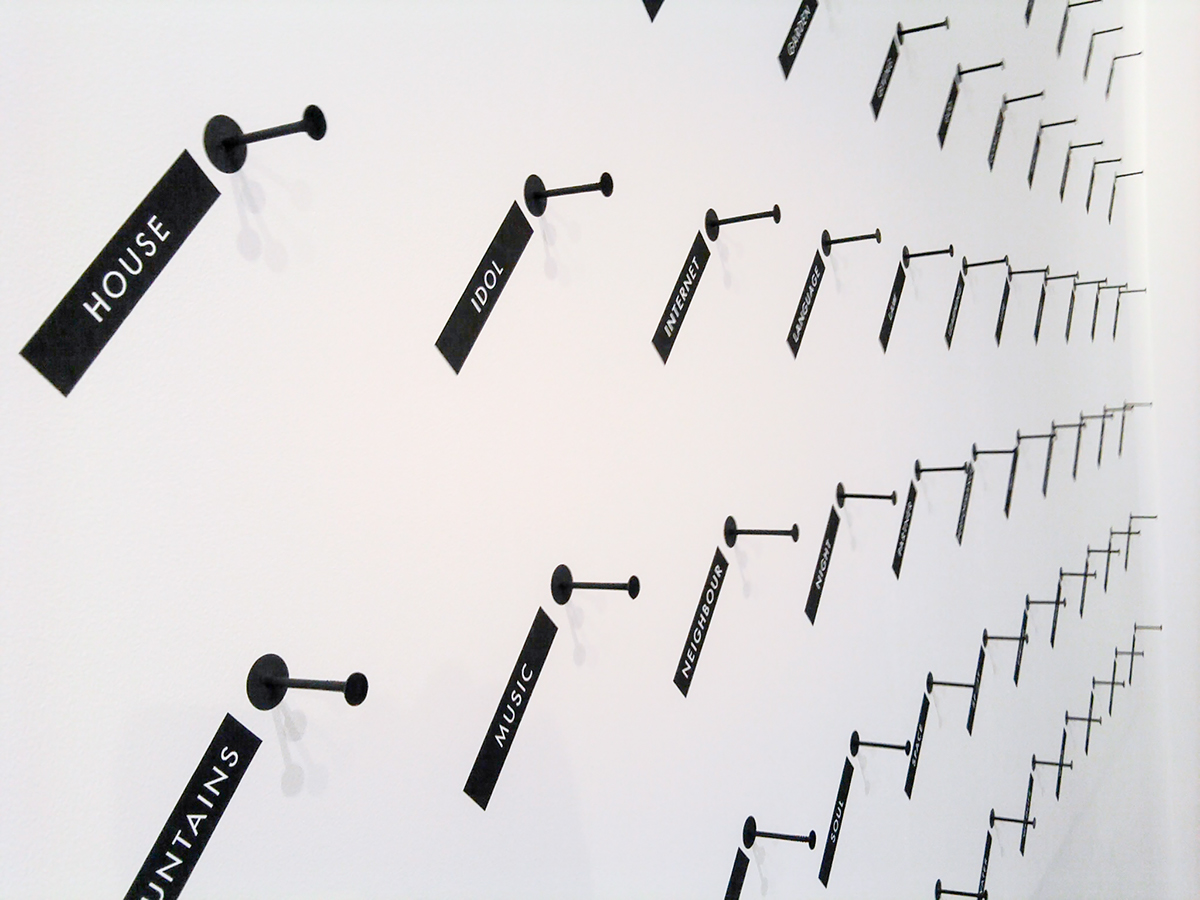
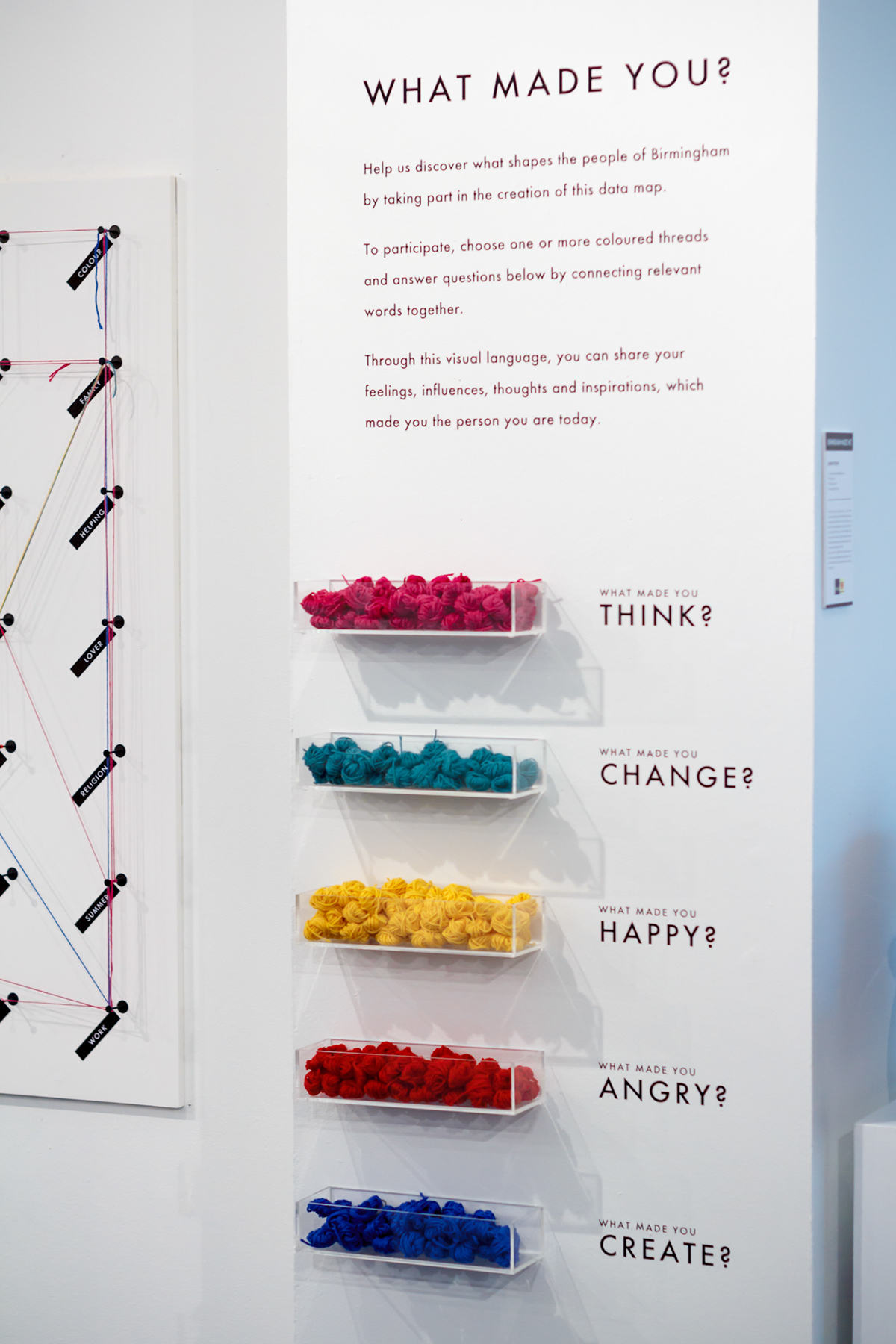
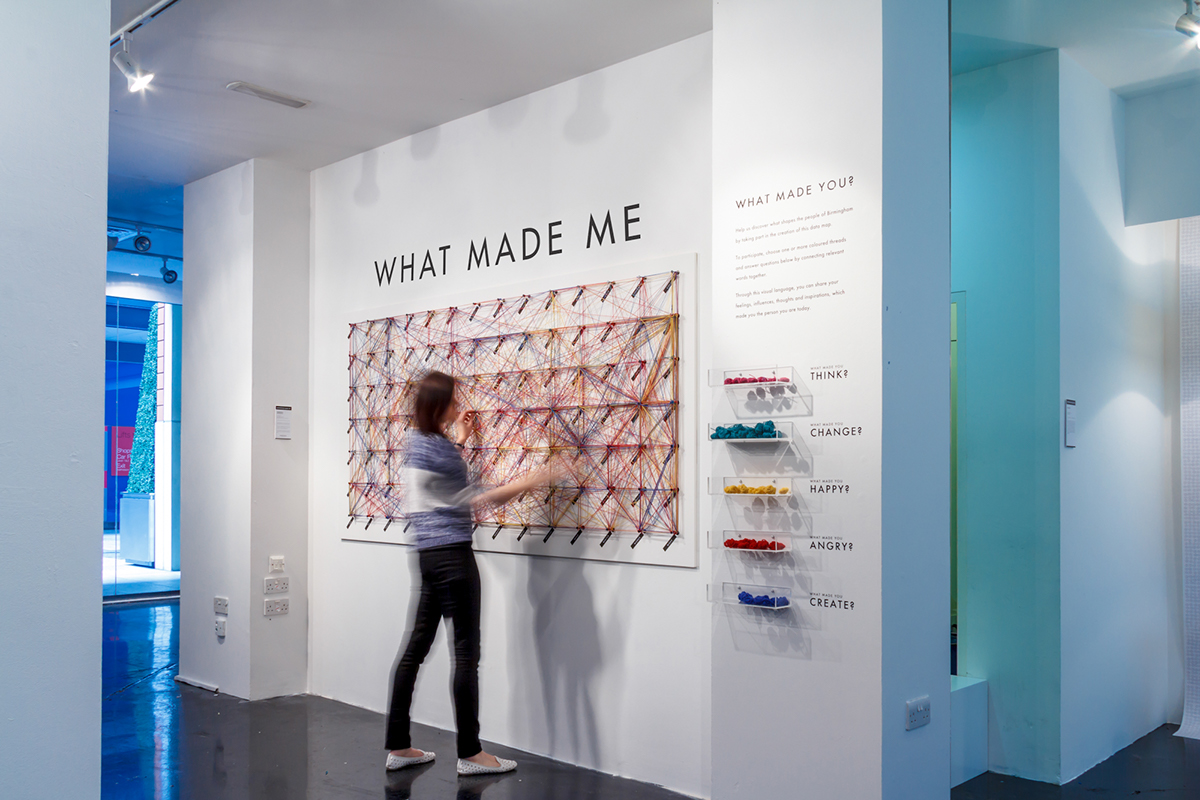
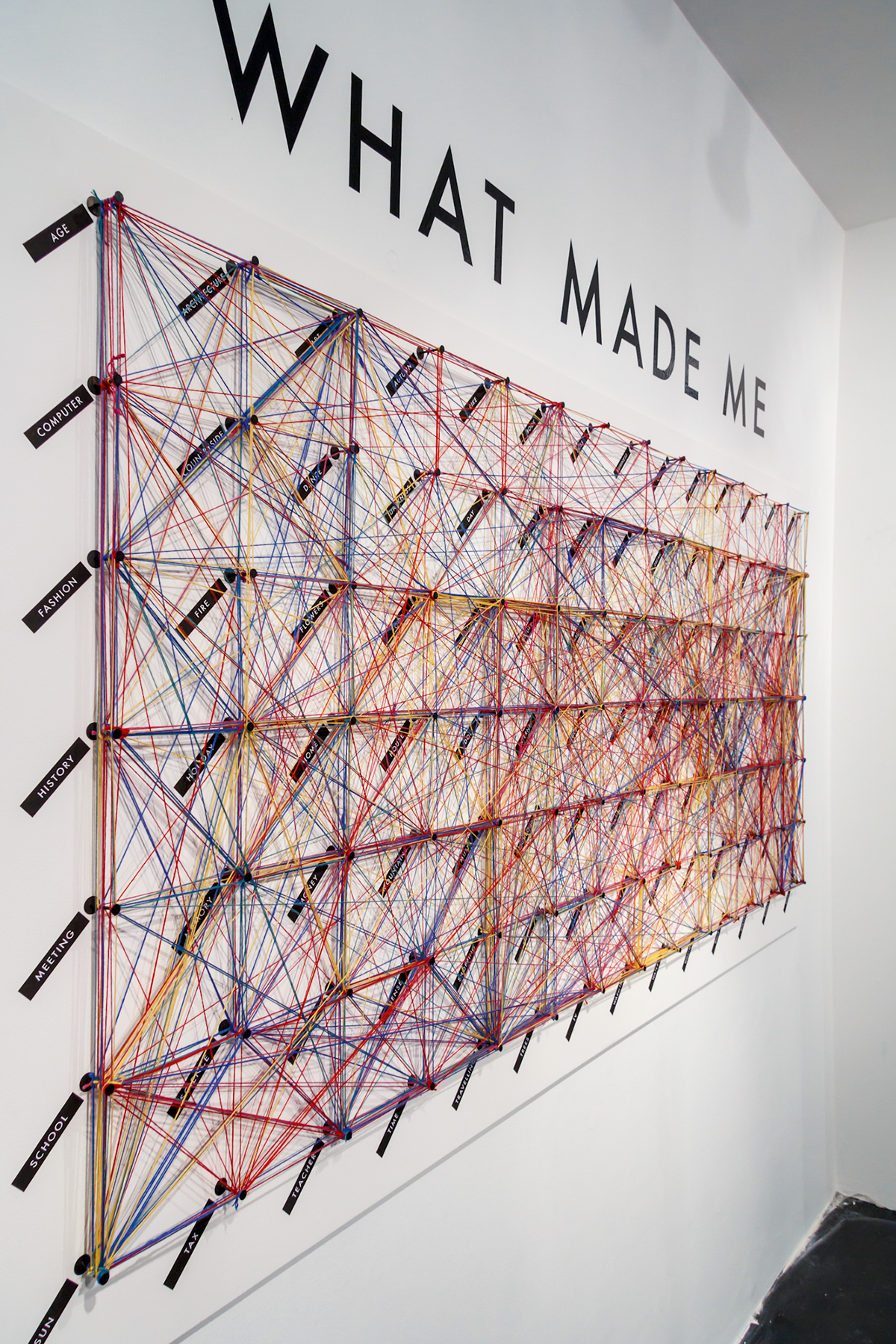
With All Our Senses by Fraunhofer Gesellschaft at Mainau Discoveries (2011).
This exhibition invited the audience to see, touch, hear and smell. They are then taught about the science behind each of these senses.
http://www.claudiaschleyer.com/fraunhofer-gesellschaft#/i/0

The Wishing Wall, Times Square NYC, (2011) encouraged new years eve party-goers to share their hopes and dreams for the coming year on pieces of confetti, the notes were then collected and added to the confetti released when the New Year hit.







Rebecca Jackson - The Quilt Project
Rebecca runs different meeting groups around Manchester, to help people who have lost loved ones to suicide. Through these workshops she is currently working on a quilt project, which will run as a series of textiles workshops, in the aim that she can collect a range of 'patches' for a large scale quilt, which will each represent someone lost to suicide. This exhibition is planned to be exhibited in Manchester Art Gallery in September.



Hart club is a charity led organisation encouraging neurodiversity in the arts, exhibiting work with the aims to build confidence, community and well-being. They work closely with different organisations who run art clubs for neurodiverse artists, providing a space for them to exhibit the works created during these workshops.

The Great Grey, is a workshop which works with people suffering from dementia, Hart Club provides a space for these workshops to take place, and also an opportunity for the group to display their creations in their gallery space.
Hart club is a very unique place, a small studio in South East London with a printing room and ceramics studio, their walls are decorated with clients art.


The group seemed very relaxed, playing music in the background as the clients painted and had tea, cake and small talk. The leader of the group, an art-psychotherapist, was very relaxed with a friendly relationship with the artists, encouraging them gently to keep creating even when they felt like giving up. After speaking with the group leader, and the lady who runs Hart club, we discussed how it was important to be very sensitive with the group, safe-guarding is a major issue while attending the groups, and although it would be a nice idea to show their work, it would also be exposing their identity, and putting pressure and stress on them they may not want. Therefore I thought we could take a different approach to the project, maybe working with the psychotherapist herself to gain a stronger understanding of the importance of art therapy, how it works and how it benefits the clients. We would like to keep working with the group, but not to learn their stories - which may be difficult and distressing to communicate - but instead to think about the generalised story of art-therapy and how we can apply this to our own workshop.
One of the activities we did was a 'brain-gym', where the leader of the group encouraged us to work in pairs to create a piece in turns, in order to encourage a visual conversation. We first looked at a range of artists, discussed the mood we felt looking at these artists, and cried to create our own piece by applying a similar mood.
Without the clients permission I cannot show their work but in pairs we also created individual pieces, this was mine:

It was nice to see how we were able to inspire each other to create, and how the person I worked with became more animated and more confident as the session progressed.
What is dementia?
Dementia is a syndrome which affects brain functionality, causing problems with:
- Memory loss
- Thinking speed, mental sharpness, and quickness
- Language
- Understanding and judgement
- Mood
- Movement and capability to complete daily tasks
The two most common types of dementia are Alzheimer's Disease and Vascular dementia.
Alzheimer's Disease is a progressive condition causing; disorientation, memory loss, anxiety, depression, hallucinations, personality changes, issues with language and issues with self-care. The Disease affects 1 in 14 people over the age of 65, and 1 in 6 of people aged over 80. There is no cure for the disease yet medication is available to alleviate symptoms and steps can be taken to keep the sufferer living independently as long as possible.
Vascular Dementia, is caused by reduced blood flow to the brain causing a decline of brain function, and a development of dementia symptoms. Again there is no cure for this type of dementia, however as this type is caused by a medical condition, lifestyle changes and medical intervention can help slow it down.
What is art therapy?
Art therapy is a form of psychotherapy which uses art media as a primary source of expression and communication. Within this context art is used not as a diagnostic tool, but as a medium to express emotional issues which may be confusing or distressing
- BAAT (British Association of Art Therapists)
- Art therapy can be useful for a range of clientele needs such as emotional/behavioural/mental health problems, physical illness, learning or physical disabilities, life-limiting illness, and neurological conditions.
In this video the client discusses how art-therapy allowed her to visually communicate the difficult body-image issues she was struggling with. The sessions allowed her to channel different difficult emotions such as anger through her art. Finally she felt that the art she was creating provided a distraction from her mental illness, it helped build her confidence and helped her discover a new passion.
In this video the client explains how art therapy allowed her to discuss the elements of her eating disorder which are often difficult to explain such as her relationships to food and meal-times. She discusses how art-therapy allowed her to look back onto her past emotions, which allowed her to recognise her own recovery.
Interactive exhibitions
Interactive exhibitions combine different mediums and technology in the aim to give the audience the role of the exhibition-maker
Welcome to Hard Times was an interactive exhibition in Prague which forced its audience to consider their own involvement in the world today and the political climate, encouraging them to fight back, with things such as political leaders faces on punching bags.
What Made Me was an interactive exhibition designed by Dorota Grabkowska (June 2012). The idea of the project was to map what shaped the city of Birmingham by asking them five questions: What made you think? What made you create? What made you happy? What made you angry? What made you change? Each question assigned a different coloured thread and audience members were encourage to use the thread to connect words in a grid to share thoughts.
https://www.behance.net/gallery/4419469/WHAT-MADE-ME-Interactive-Public-Installation




With All Our Senses by Fraunhofer Gesellschaft at Mainau Discoveries (2011).
This exhibition invited the audience to see, touch, hear and smell. They are then taught about the science behind each of these senses.
http://www.claudiaschleyer.com/fraunhofer-gesellschaft#/i/0
The Wishing Wall, Times Square NYC, (2011) encouraged new years eve party-goers to share their hopes and dreams for the coming year on pieces of confetti, the notes were then collected and added to the confetti released when the New Year hit.


The Happy Show by Stefan Sagmeister is an interactive exhibition space labelled as an 'experience', located in LA.





Rebecca Jackson - The Quilt Project
Rebecca runs different meeting groups around Manchester, to help people who have lost loved ones to suicide. Through these workshops she is currently working on a quilt project, which will run as a series of textiles workshops, in the aim that she can collect a range of 'patches' for a large scale quilt, which will each represent someone lost to suicide. This exhibition is planned to be exhibited in Manchester Art Gallery in September.




Comments
Post a Comment